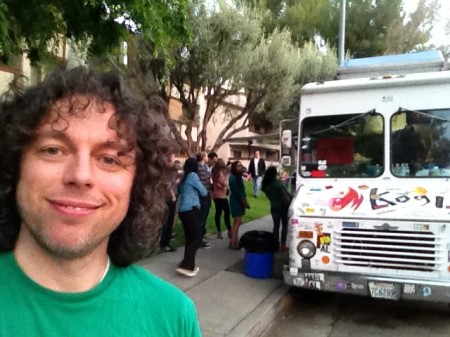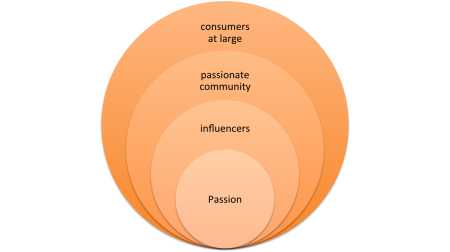The Archives
-
Experience Design, Marketing, Travel & Tourism
Cascading influence in tourism marketing
05.16.12 | Permalink | 4 Comments
I’m not a foodie. But I like food. I like cooking. I like to eat good food. I like authentic experiences. I like holes in the wall. I once drove 5 hours to eat deep fried cheese. And when I was in LA last month I drove an hour to visit the Kogi food truck (photo). But I don’t really watch food shows, read food blogs or base every restaurant I visit on reviews on Yelp or Tripadvisor.
I have friends for that.
My friend Stephanie is a foodie. She tries crazy recipes and knows about all the new and hot restaurants in town. And beyond. There aren’t a lot of cities I travel to where she doesn’t know of someplace amazing.
Stephanie is not a big food influencer. She doesn’t blog, doesn’t take photos of her food, she doesn’t pin food recipes. She does influence her friends though. In person or on Facebook. And if she recommends a restaurant, I’m going.
I’m not a foodie. But I’m influenced by one.
Stephanie in turn, is influenced by a host of people who share her obsession with food. She’s part of a passionate community of foodies. A lot of her friends are foodies, she watches Food TV, reads a lot of food blogs, is active on Chow and follows celebrity chefs on Twitter.
Stephanie is a foodie. She makes her decisions based on information from influencers in the foodie community.

The example above is the essence of modern tourism marketing. Restaurants will get people like me in the door because I’m influenced by a foodie, who in turn is influenced by leaders in the foodie community.
As a marketer, you need to approach this in reverse. Activate the influencers who connect with the passionate community, who in turn connect with consumers at large.
This works for any kind of niche. Hiking, skiing, modern art, theatre, gambling, roller coasters, etc. There are thousands of passionate communities and each community, large or small, has influencers. It’s just a matter of activating it.
As a tourism marketer you need to identify your niches and ensure the delivery of your experience is remarkable so people will recommend your destination or product. It will start a cascading effect that produces long term results.
-
Management, Marketing, social media, Travel & Tourism
5 levels of social media sophistication at the DMO
04.23.12 | Permalink | 34 Comments
Imagine you had to start a DMO. Your DMO. You have been given the same budget and must start from scratch. Would your DMO look exactly the same as it does now? The same departments, same positions? The same budget allocations? The same marketing tactics?
The internet, and social media in particular, have completely changed tourism marketing. Forever. People might not talk on Facebook about which fabric softener they use or which soft drink they prefer, but everybody talks about their travels. Social media sophistication is crucial to modern marketing. Yet the tourism industry is way behind.
We have worked with dozens of DMOs around the world, ranging from very small to very large. And we have spoken to hundreds more. Based on our conversations and experiences we have identified the following levels for social media adoption and integration into the organization.
1) Ignoring social media
This level represents DMOs who are not active at all in social media. Social media is seen more as a threat than an opportunity.Characteristics you can find at this level are:
- Leadership that is very skeptical of social media (“Facebook is a waste of time,” “I don’t care what my old high school buddy had for dinner last night,” “Twitter is for young people,” etc.)
- Fear of negativity
- Restricted staff access to social networking sites through policies or technology
- Lack of an internal social media champion
- Lack of social media knowledge at marketing agencies
- Traditional marketing methods
- No budget for social media
Two years ago, there were many DMOs at this level, but by today most have moved on. Most DMOs that remain here are tied to very restrictive government policies.
2) Experimenting with social media
DMOs experiment with social media without a specific strategy through random tactics.Characteristics you can find at this level are:
- Leadership that is skeptical, does not know activities are happening, ignores them because of disinterest, allows it because an influential stakeholder asked questions, or is swamped dealing with politics
- Fear of negativity and overreaction when something “bad” happens
- Enthusiastic internal champions who have created rogue accounts but sometimes lack skills to properly execute. These people eventually leave the organization to properly grow their skills elsewhere
- Hit or miss results
- Chasing anything that is new and hot
- Lack of social media knowledge at marketing agencies
- No or very little budget
- No metrics
There are still a lot of DMOs operating at this level. It often takes a noticeable event to move them to the next level. This could be spurred by a social media success internally or by the DMO next door. For example, a rival’s viral YouTube video or growing number of Facebook fans.
3) Social media supporting marketing campaigns
Due to a lack of strategic knowledge, DMOs incorporate social media in paid, outbound marketing campaigns. Often this is an add-on to traditional marketing campaigns, such as a YouTube channel showing videos originally made for TV or using Facebook and Twitter to broadcast campaign messaging.Characteristics you can find at this level are:
- Leadership that realizes social media can be powerful but still relies/insists on traditional methods because they are more comfortable with them, or do not know how to measure and compare the difference in results
- Marketing agencies that reluctantly incorporate social into campaign strategies, often as an afterthought and/or without understanding social media principles
- Little integration or collaboration with members/partners/industry
- Heavy scheduling and approval processes for social media activity
- Broadcast-style communication in social media
- Viewing and communicating with fans and followers in a traditional outbound marketing way, such as a consumer email database
- Year-round efforts on Twitter, Facebook, etc., that lack strategic direction
- Social media black-outs when there is no campaign in market
- Frustrated and/or maxed-out staff who understand the potential of social media but are not heard by leadership and sometimes need/want more training
- Often staff skilled in social media leave the organization out of frustration
- Budget that is a small portion of marketing campaigns
- Lack of appropriate metrics, with success often measured either by big numbers (# of fans/followers) or a campaign’s level of creativity
Most DMOs operate at this level, sometimes with some additional effort to keep Facebook and Twitter going year-round. Often the level of success depends on the sophistication of one or two staff members.
DMOs at this level want to succeed but cannot break out of the traditional way of doing business. Getting to level four is usually achieved by having a strong social media success as part of a bigger initiative or having an epiphany that social requires a different way of thinking. Usually, level two experiments continue alongside level three activity.
4) Following a social media strategy
This level is typified by a DMO having a social media strategy in place or having social media integrated into its marketing strategy. The DMO still believes that it is in full control of the destination brand.Characteristics you can find at this level are:
- Leadership that understands social media and has given it dedicated resources
- Marketing campaigns that have social at the core
- Agencies in place that are dedicated to social or a digital agency that (really) gets social
- Social strategies in place tied to marketing goals and objectives
- Stronger alignment/integration with members/partners/industry and other stakeholders
- A move from mass to niche marketing
- Activities that are measured and adjusted in real time
- Staff that is trained in social media
- Empowered staff that is allowed and encouraged to participate as a DMO professional in social networks
- Social media monitoring and engagement that is in collaboration with members/partners/industry
- Social media that is incorporated in customer service
- Relaxed social media access policies and limited approvals for posting content
- Crisis plan in place
- Systematic experimentation that is part of the strategy
- Dedicated staff and budget for social media
Leading DMOs have entered this level. Over the next few years we expect a rush of DMOs moving here. DMOs that enter level four first are the ones with less restraining operating environments (such as funding) with innovative leaders and marketing managers.
5) Embracing the social business model
The level five social business recognizes that the destination’s story and reputation are based on visitors’ experiences at every touch point during their trips (see point 1 in “Top 5 Wrong Assumptions in Destination Marketing”). This DMO knows and accepts that it is no longer in control of the destination story. It recognizes and acts on the need to collaborate closely with its industry, residents, influencers and visitors, and that it must change the way success is measured.
The level five DMO starts with the core of the passions that make a destination relevant and leads all partners that have an impact on those experiences. The sole focus is on delivering outstanding visitor experiences that are unique to the destination, and then making it easy for visitors to share these experiences in their own voices.
As painful as it may be, the DMO re-organizes, ending much of its old way of doing business. Staff is re-trained and assigned to new activities.
Characteristics you can find at this level are:
- Leadership that understands that business models from 15 years ago must change and is willing to undertake the pain of changing the organization
- Relentless focus on the consumer
- Majority of marketing resources are allocated to digital
- A shift from destination marketing to destination management, where the customer experience is seen as the primary way to build brand
- Marketing strategies that are a collaborative effort between the DMO, industry, residents, passionate consumers and other stakeholders
- A move from mass marketing to niche marketing
- Culture of collaboration, internally as well as with members/partners/industry and even consumers
- Flattened organizational hierarchy to increase efficiency and speed needed to respond and adjust quickly
- Lean processes
- Staff that is trained, empowered and supported to make decisions without requiring lengthy approvals or spending time in meetings designed by management to control every aspect of every tactic
We’re not aware of any DMOs at level five. We have spoken to many DMO executives who know they need to get here and want to get here. Often, their funding models or destination-specific politics stand in the way.
The DMO closest to a level five we are familiar with is Visit Sørlandet in Southern Norway. As a newly created regional DMO, this organization quickly realized it would be impossible to build a Southern Norway brand the traditional way. By creating a strategy based on collaborating with local DMOs and industry members to improve the visitor experience and elevate the collective digital marketing efforts, Visit Sørlandet is building it’s brand through every touchpoint while growing repeat visitation and encouraging word-of-mouth.
For many DMOs that have not reached level four, level five may seem pie in the sky. But the further you move your DMO through the levels, the more you realize just how much the world has changed and the true impact this has. Once you enter level four, you can see level five. It is no longer pie in the sky. It is tomorrow.
At what level is your DMO?
Your DMO’s current level is not a sign of success or failure. Every DMO is different. Politics and funding models have a big impact. So does the size and scope of a DMO. A country DMO is different from a city DMO. This affects specific marketing strategies and tactics.It is also not a race. It is a process that organizations need to go through. Some might skip a step. For others, the levels could overlap. But in order for DMOs to stay relevant and effective, they need to climb up.
We have worked with DMOs in all shapes and sizes at every level of this process. We enjoy helping DMOs make the climb.
We have conducted audits, started Facebook pages, trained staff, implemented social media as part of bigger campaigns, run social campaigns, created strategies, helped to define entire business plans centered around social principles and much more.
Inventing the future
Alan Kay, the inventor of the GUI and object-oriented programming once said, “The best way to predict the future is to invent it.” Instead of all DMOs trying to invent level 5 independently, we think the best future is that we all invent it together and collectively stay relevant. Please share your thoughts in the comments.As always, thanks for all my Think! coworkers for their contributions in creating this post
-
Internet, Marketing, Travel & Tourism
The paradox of choice
08.06.09 | Permalink | 6 CommentsInteresting posting (as usual) from Stephen Joyce from Rezgo. He touches on a few things I’ve thought about a lot over the years. Especially the paradox of choice.
He makes a good point.In an industry where there is so much choice, how do you reduce choice? One answer is to specialize. Yes, that’s right, when you specialize in a destination or a product type, you reduce your customer’s choice and increase their ability to make a decision.He’s right. And the internet allows operators to find a very specific niche segment of consumers. This just wasn’t possible 10 years ago. By finding a profitable niche, it allows operators to tailor the product or experience and make it remarkable. And soon, your niche product, targeted and tailored to the Italian fly-fishing audience is being talking up on the Italian fly fishing social networks.
One of my dilemmas as a online destination marketer is: do I carve the destination up in niche websites (a cheese specialty store), tailored and targeted at specific segments, or do stock all product in one big website (a supermarket). Since travel is a multi-product experience, we’ve opted for the supermarket concept (like most DMO’s). No two trips consumers make are the same, because they all have unique preferences. Even the Italian fly-fishers will need a place to stay, eat and fill their time with other things, and that’s where we come in.
But the paradox of choice does creep into my mind every once in a while. That’s why I think the approach to allow consumers to make incremental decisions that won’t overwhelm them with too many options is a way to overcome this. That’s where regions, cities and sectors are useful. But it remains tough.
I think websites like Kayak do a good job of giving their users tools to limit a consumers choices based on personal preferences. I want a 4 star hotel, downtown, with a pool for example will reduce choice and make the decision process easier. The industry needs more of that. It will also stop the process of commoditizing tourism product.

